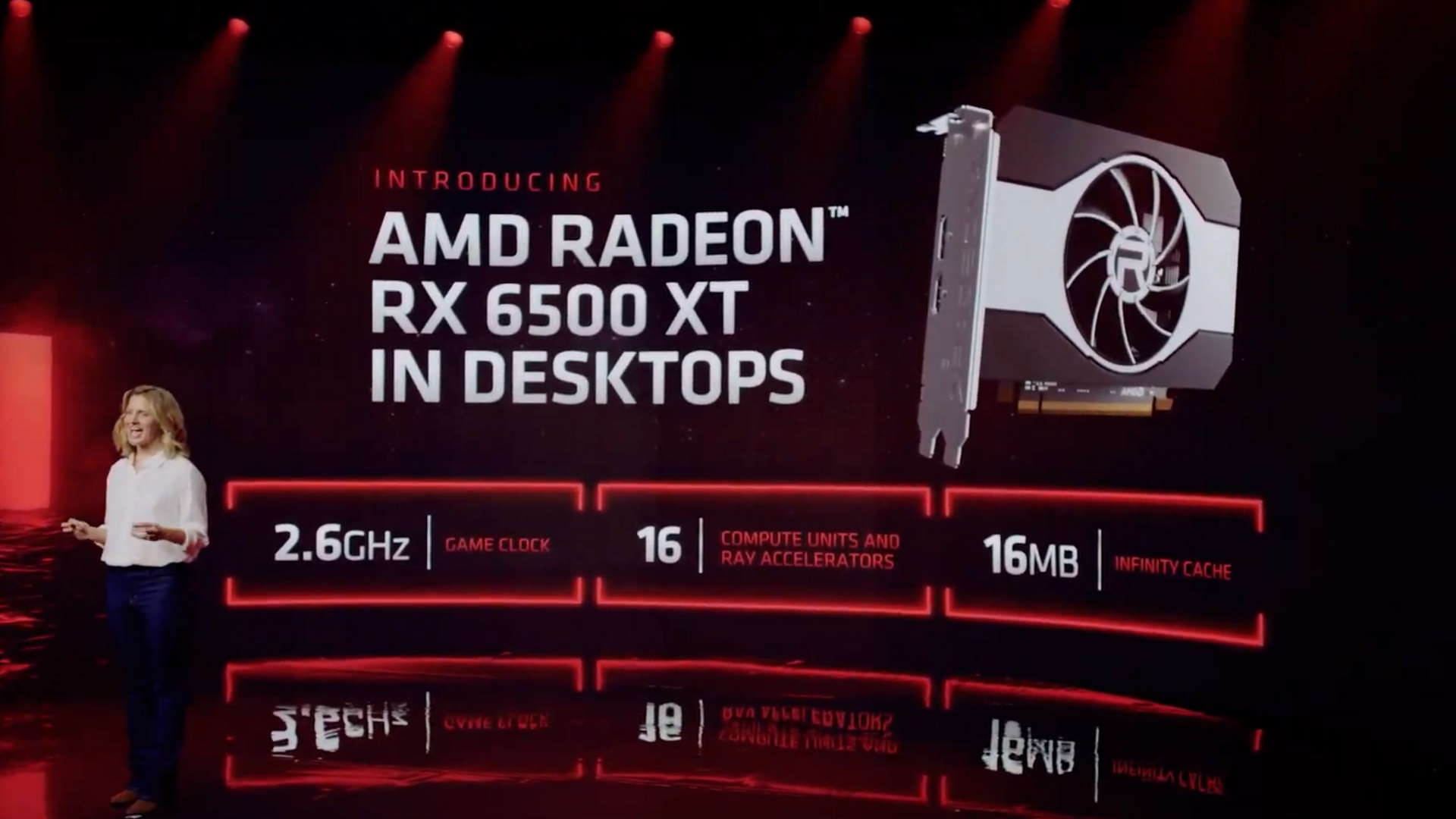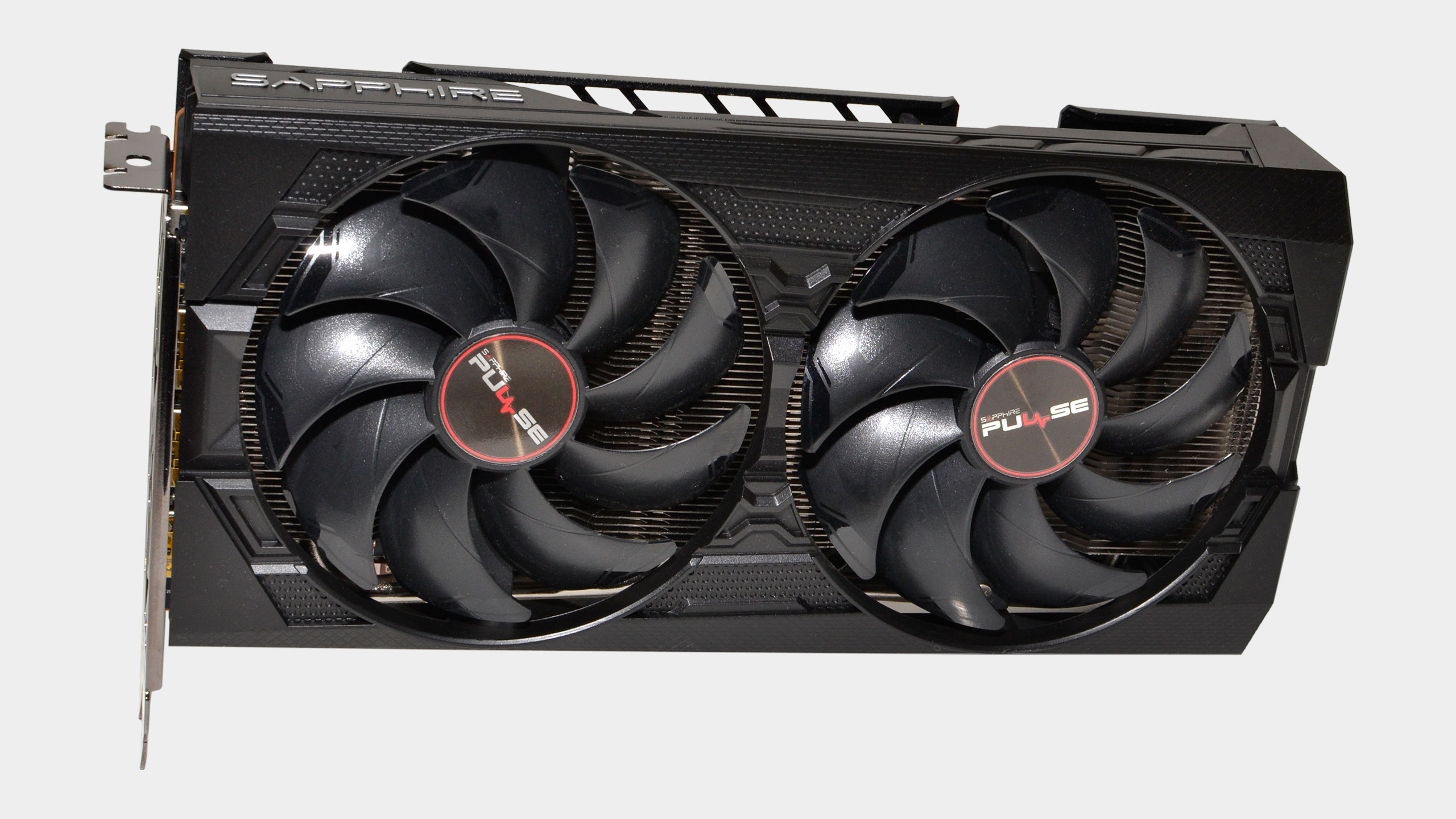The $199 RX 6500 XT looks worse on paper than AMD's $199 GPU from six years ago
The Radeon RX 6500 XT looks weaker than the old RX 480, but here's hoping there's some magic left in those RDNA 2 cores for budget gamers.

One of the most interesting things to happen at CES 2022 from a PC gaming perspective was that both AMD and Nvidia finally revealed this generation's sub-$250 graphics cards. While we're still waiting for more specs and performance details about Nvidia's RTX 3050, there are some depressing things to note about AMD's Radeon RX 6500 XT, most especially when you compare it with the $199 Radeon RX 480 AMD launched back in 2016.
The performance increases we've seen in graphics cards over the last few years has been astonishing. We've been treated to the most powerful GPUs ever to grace a PC, slices of graphical silicon capable of pixel-pushing feats we could hitherto only dream of. But that's come at the expense of affordability with even today's third-tier graphics cards costing upwards of $700.
When you put the twin mood-killers of a global pandemic and a global chip shortage into the equation you also get a situation where it's not financially prudent to create lower-priced GPUs that will be in high demand. Not when you can just make expensive products, which are in just as high demand, and watch those fly off the shelves anyway.
So we've had to suffer higher-priced GPUs and an obvious lack of mainstream graphics cards for the normal humans unable to spend their entire bank balance on a new card.
But now we're finally getting new, affordable RX 600-series and RTX 3000-series graphics cards. Though, while it's great to see both the GPU makers finally releasing budget graphics cards, it's painful to see just what that means in terms of their specs. These look to be every bit the pandemic GPUs of our worst nightmares, I just hope I'm wrong about them.
What we always want to see is higher performance and higher specs compared with the same price GPUs of the last generation, and that is tangibly not the case with the RX 6500 XT. Okay, so the jury is still out on actual gaming frame rates from the new Radeon until we get it in our test bench, but our experiences with the RX 6600 XT—essentially an RX 5700 XT for the same price—and a read of the RX 6500 XT specs sheet don't fill us with confidence.
I mean, this stark image comparison from reddit illustrates the issue perfectly…
The biggest gaming news, reviews and hardware deals
Keep up to date with the most important stories and the best deals, as picked by the PC Gamer team.
| Header Cell - Column 0 | AMD Radeon RX 6500 XT | AMD Radeon RX 5500 XT | AMD Radeon RX 480 |
|---|---|---|---|
| Release date | January 2022 | December 2019 | June 2016 |
| Shader Cores | 1024 RDNA 2 | 1408 RDNA | 2304 GCN |
| ROPs | 32 | 32 | 32 |
| Texture Units | 64 | 88 | 144 |
| Memory | 4GB GDDR6 | 4GB GDDR6 | 4GB GDDR5 |
| Memory bus | 64-bit | 128-bit | 256-bit |
| Memory bandwidth | 144 GB/s | 224 GB/s | 224 GB/s |
| Processing power | 5.77 TFLOPS | 5.20 TFLOPS | 5.83 TFLOPS |
| Board power | 107W | 130W | 150W |
| Price | $199 | $169 | $199 |
When it comes to raw GPU performance, the RX 6500 XT comes in at 5.77 TFLOPS, while the old (and still competitive) RX 480 managed a healthy 5.83 TFLOPS. The older card, even in its $199 4GB guise, has higher memory bandwidth, far more shader cores, and way more texture units.
There's a chance that 16MB of Infinity Cache can make up for the shortfall of the RX 6500 XT's 64-bit memory bus, by boosting that bandwidth. When we initially checked out the Infinity Cache architecture with the Radeon RX 6800 XT, AMD told us cache hits were more likely at 1080p resolutions—where budget cards are aimed—which means the extra bandwidth afforded by the smart cache tech ought to help.
But it may only help in that it gets it to perform at the same level as an older, higher specced GPU using otherwise weaker silicon. I guess that's progress, but only if the price tag were lower. Maybe those RDNA 2 cores will deliver some magic we've not previously seen, but they're going to have to work damned hard. I guess that's where the 2.6GHz clock speed is meant to come in.

It could then potentially give the last-gen 4GB RX 5500 XT a run for its money then, but that's another depressing indictment of the state of the GPU market, because that was a cheaper $169 card when it launched at the tail end of 2019.
But this all seems to be part of an AMD strategy to put gamers first; by giving them graphics cards too weak to be worthwhile for mining and therefore more available to the rest of us.
Speaking at a CES roundtable, Laura Smith, CVP of Radeon Graphics at AMD said of the RX 6500 XT specs: "We have really optimized this one to be gaming-first at that target market. And you can see that with the way that we configured the part. Even with the four gigs of frame buffer. That’s a really nice frame buffer size for the majority of AAA games, but it's not particularly attractive if you're doing blockchain type activities, or mining activities.
"And so we've tried to make some real gamer-first transitions for the things that we don’t control but we have influence over to optimize that card to be as accessible as possible to that use of gamers."
On the Nvidia side, I've yet to be convinced the RTX 3050 is going to be in much better shape gen-on-gen. That's a $250 GPU, and likely to be significantly quicker than the RX 6500 XT, but I'd be surprised if we weren't just looking at GTX 1660 Ti performance for $30 less, though with the promise of DLSS support.
So, thanks CES 2022, for kicking the year off in depressing GPU style.

Dave has been gaming since the days of Zaxxon and Lady Bug on the Colecovision, and code books for the Commodore Vic 20 (Death Race 2000!). He built his first gaming PC at the tender age of 16, and finally finished bug-fixing the Cyrix-based system around a year later. When he dropped it out of the window. He first started writing for Official PlayStation Magazine and Xbox World many decades ago, then moved onto PC Format full-time, then PC Gamer, TechRadar, and T3 among others. Now he's back, writing about the nightmarish graphics card market, CPUs with more cores than sense, gaming laptops hotter than the sun, and SSDs more capacious than a Cybertruck.

